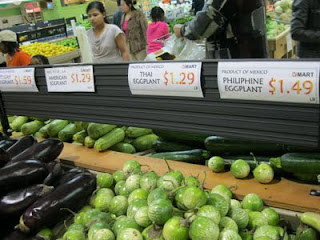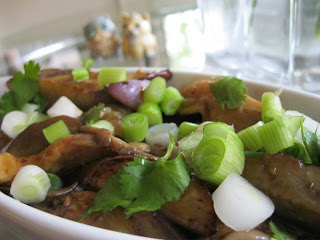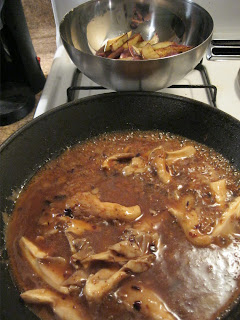(See last entry for explanation of this particular challenge.)
The manner in which my eggplant-related activities are presented on this blog may lead you to believe that I conducted the Thai/Talong taste-test before attempting to cook a dish. This would have been smart. But no, alas, I stupidly barged ahead and made a dish with Thai eggplants before conducting preliminary experiments.
The result was a dish that, while it appears appetizing in photos, was a bit of a failure. I feel, however, that this presents a perfect opportunity to talk about improvisation in the kitchen, the potential for disaster, and learning from mistakes.
Well... namely that. Improvising in the kitchen is fun, failures happen, and mistakes teach.
For instance, before I attempted to cook with Thai eggplants, I assumed that they would be just like every other variety I have cooked – frying them in oil would break them down quickly, at which point they would assume the ideal state of creamy softness. It turns out, though, that Thai eggplants are different from other varieties in the following ways:
a) With the exception of a thin layer of flesh on the outside, Thai eggplants are densely packed with hard seeds.
b) Because of this, they take ages to break down. I fried them in steep oil for about 10-15 minutes before they softened.
c) Once the eggplants break down, the patterned skin blisters and peels off in an unattractive fashion.
 |
| Full of seeds. |
In future, I would cook the eggplants in such a way that I could remove the seeds and skins before serving (e.g., oven-roasting). I’m curious to know how they are prepared in Thai cuisine (all the eggplant dishes I’ve eaten in Thai restaurants are cooked with Chinese eggplants). Do Thai people simply eat the seeds? Do the seeds provide an important texture element? Or are the eggplants meticulously de-seeded and skinned before they are tossed in the wok?
My pseudo-failed experiment was Thai eggplants with kumquats in kumquat-garlic sauce.
Somehow, in my mind, this was going to be obscenely delicious because I recalled eating whole kumquats as a child. My nostalgia caused me to forget how strong kumquats are, such that I used way-too-many way-too-large chunks. The sauce also turned out a bit sour from all the kumquat juice and pulp.
 |
| A soy-sauce-based garlic sauce with kumquat juice instead of rice vinegar. |
 |
| I used a few of these Thai bird's-eye chilis whole to impart spiciness. These chilis are almost as hot as habaneros, so take caution. |
 |
| My mother owns a wok, allowing me to appear badass while cooking. |
 |
| The eggplants took forever to cook, probably owing to the seed pockets. |
 |
| Eventually they broke down; here you see the blistering peels. |
 |
| I fried some onions with juiced kumquat halves. |
 |
| Then added the sauce. |
 |
| Then simmered everything together. |
The recipe was not entirely a bust, however. The sourness of the sauce was tempered after the dish sat out on the counter for a couple hours. The kumquat flavor did turn out to be a nice complement to the garlic sauce. And above all, it looked kind of pretty.
 |
| Appears appetizing... |
If anything, I hope my tale of eggplant-woe will encourage, rather than discourage, kitchen improvisation. You never know when one of your kitchen experiments will yield superb results; and if it fails, it was a learning experience. I, for instance, learned that I am generally lousy at Asian cooking.
But ideally, all kitchen experimenters have significant others with no taste-buds who will unquestioningly gobble up the failed leftovers. Right?
But ideally, all kitchen experimenters have significant others with no taste-buds who will unquestioningly gobble up the failed leftovers. Right?

















































